Vatnavinir in Reykjavik City
Ideas for more activities in tourism in Reykjavik
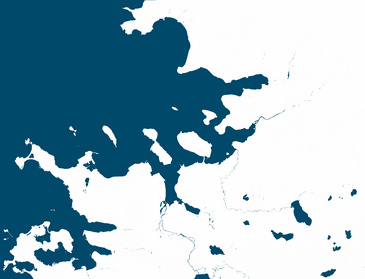 Reykjavík has a long history of bathing, which stretches all the way back to the settlement period. Story has it that Hallgerður langbrók, who lived in Laugarnes, bathed in a hot spring tempered with water from a cold stream. The bathing history of Iceland is important and unique and it enhances quality of life in the city to have such ready access to excellent swimming pools. But the offer of bathing experiences in Reykjavík is rather homogenous as all pools serve a similar function and are directed at a broad target audience. Vatnavinir see endless opportunities for increased variety of bathing experiences and that Reykjavík could create a unique position for itself as a bathing and health city close to nature.
Reykjavík has a long history of bathing, which stretches all the way back to the settlement period. Story has it that Hallgerður langbrók, who lived in Laugarnes, bathed in a hot spring tempered with water from a cold stream. The bathing history of Iceland is important and unique and it enhances quality of life in the city to have such ready access to excellent swimming pools. But the offer of bathing experiences in Reykjavík is rather homogenous as all pools serve a similar function and are directed at a broad target audience. Vatnavinir see endless opportunities for increased variety of bathing experiences and that Reykjavík could create a unique position for itself as a bathing and health city close to nature.
Vatnavinir proposals in Reykjavík emphasise the linking of bathing places to nature that is readily and widely found within the city limits and all around it. This is an interconnected network of bathing places large and small – by the seaside or in amongst lava fields and forest trails. This network could form the basis for sustainable tourism not to mention improving the quality of life of those who inhabit the city all year round. By linking bathing places to the development of outdoor areas and network of paths in the greater city area, synergy between parties with similar goals can also be encouraged.
In spring 2009, Vatnavinir submitted proposals to a contest of ideas initiated by Höfuðborgarstofa (Visit Reykjavík) to improve the tourism offer of the city. In October 2009 conclusions were announced and Vatnavinir received a grant to develop further proposals for a Harbourn Bath by Ingólfsgarður and History Baths in Laugardalur. These proposals were introduced in May 2010.
BATHS IN REYKJAVIK HARBOUR
The Harbour baths are situated on Ingólfsgarður at the mouth of Reykjavík Harbour. They are 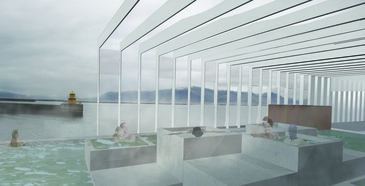 closely linked to the nearby hustle and bustle of the centre of town and the ever changing surface of the bay and the mountains that embrace it.
closely linked to the nearby hustle and bustle of the centre of town and the ever changing surface of the bay and the mountains that embrace it.
The building itself is fluid and suggestive of fish bones, steam and waves as it is white, light and suffused with steam. In front of the entrance are benches and footbaths for those that only want to bare their toes. The bathing experience inside is designed so that the smell of the sea can be sensed and the sound of waves and engine noises of passing boats heard. Between the building cloak and the harbour there is nothing but the air itself. Waves have clear access into the building so that in windy weathers when waves crash against the pier wall seawater splutters into the shower area. Here the interplay of steam and the transparent building cloak create the feeling of walls and roof being non-existent and the bather simply stands in a cloud 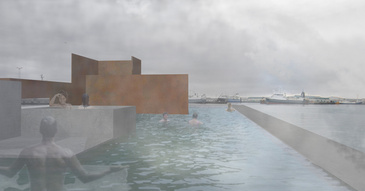 of steam.
of steam.
The water in the pool itself is heated seawater. Tubs of different temperatures in various sizes and at various heigths, for one to four people, form an island in the middle of the pool. The tubs are a reference to the fish tubs that are usually stacked up in the harbour. Windbreaks in the pool open up to sea, to harbour, in sun and shelter - or not. The curious guest may discover an opening in a wall under the surface of the water which leads to a “secret space” open only to the sky. There are also benches and areas for relaxation and cooling around the pool.
Construction and choice of materials is kept simple. The building is a shelter from weather and wind but bathers can however distinctly feel the forces of nature against their bodies.
GEOTHERMAL CENTRE IN LAUGARDALUR
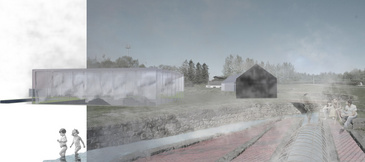 The washing springs in Laugardalur lie at the centre of the history and development of the City of Reykjavík. Here, maids washed heavy loads of clothes, people and animals bathed, boys and girls learnt their first swimming strokes, experiements were made with cheesemaking and drilling for hot water for heating and electricity.
The washing springs in Laugardalur lie at the centre of the history and development of the City of Reykjavík. Here, maids washed heavy loads of clothes, people and animals bathed, boys and girls learnt their first swimming strokes, experiements were made with cheesemaking and drilling for hot water for heating and electricity.
But steam no longer soars towards the skies and there is little to remind of old times other than stone walls by the dried up stream and grass covered washing tubs now long disconnected.
Vatnavinir propose the creation of a Geothermal Centre to honour the important history of water use in a vibrant way, e.g. by bringing to life the spirit of the old springs – the white linen blowing in the wind, the outlines of people in the steam, the smell of hot water and coffee.
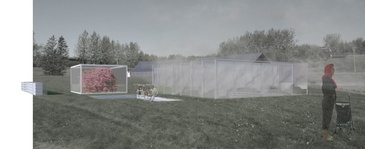 Hot water may again be supplied to the springs and the stream (Laugalækur), now contained within an underground pipe, allowed to flow again along a part of its old channel linking the Botanical Garden and the old washing springs.
Hot water may again be supplied to the springs and the stream (Laugalækur), now contained within an underground pipe, allowed to flow again along a part of its old channel linking the Botanical Garden and the old washing springs.
The baths themselves are an education centre around hot water in a historical and geological context and are underground. Guests relax in hot pools while they learn about utilisation and origin of the hot water and geothermal heat through multimedia. In the evenings silence reigns – all screens are turned off and the bath house only used for bathing - but there could be occasional events in the evenings – story and poetry evenings, film screenings, concerts or even naming of children.
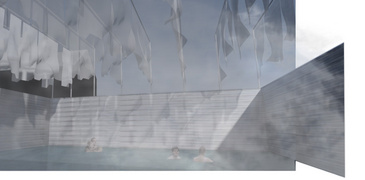 A public laundromat is also to be found here where guests and passers-by can wash their clothes. The laundromat is a historical museum on washing utensils and appliances but open to public use. Guests could choose between washing clothes on a washboard in a tub or in a washing machine from 1950. Simple refreshments, reminescent of the food washing women and travellers ate in times past, will be on sale – hot spring coffee and baked bread, fish, potatoes and meat. Paddling pools for children are in old washing tubs. The largest pool is open to the sky but beneath the present surface and white linen blows in the wind on lines above it creating a play of light and shadow in the pool.
A public laundromat is also to be found here where guests and passers-by can wash their clothes. The laundromat is a historical museum on washing utensils and appliances but open to public use. Guests could choose between washing clothes on a washboard in a tub or in a washing machine from 1950. Simple refreshments, reminescent of the food washing women and travellers ate in times past, will be on sale – hot spring coffee and baked bread, fish, potatoes and meat. Paddling pools for children are in old washing tubs. The largest pool is open to the sky but beneath the present surface and white linen blows in the wind on lines above it creating a play of light and shadow in the pool.
It is also proposed that a small steam power station be erected, which would supply the area with electricity. Thus the project – once upon a time began but never finished – would be brought full circle to its conclusion and the area thereby also made self-sustainable in terms of electricity.
